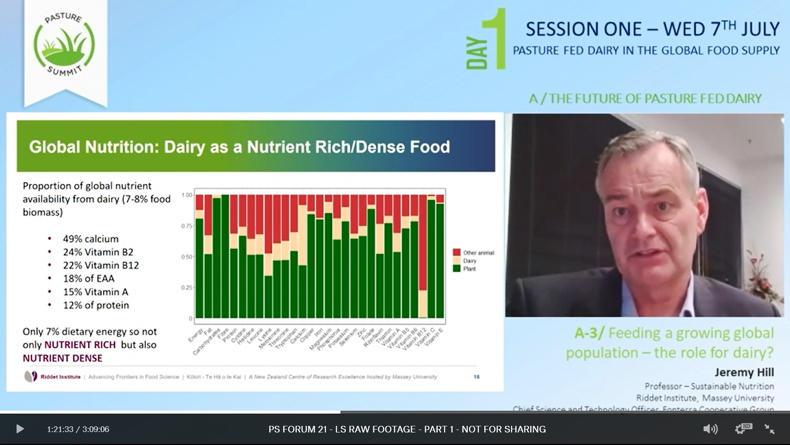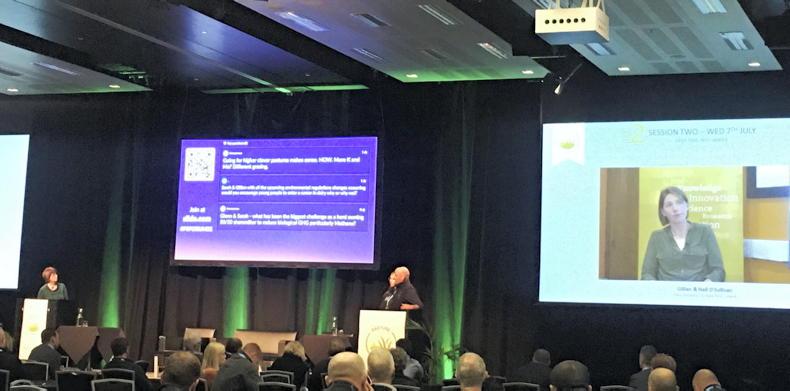With sustainability omnipresent in all farming discussions, the organisers of the Pasture Summit took a deep dive into sustainable dairy farming.
With a live audience in New Zealand and a virtual audience in Ireland and elsewhere, the event brought together over 400 farmers, scientists and milk company executives to crack heads together on dairy sustainability.
The following are some of the key points raised.
Dairy’s role in nutrition
Prof Jeremy Hill from the Riddet Institute and chief science officer with Fonterra looked at dairy’s place in global nutrition.
He recently published a paper looking at food types needed to sustain a growing global population in terms of protein, energy but also macro- and micro-nutrients.

Jeremy Hill's presentation to Pasture Summit.
Currently, 75% of the food eaten around the world is plant-based, with 25% coming from animal sources. Interestingly, a much higher proportion of food waste is from plant-based foods, at 91% of all food waste.
“Looking at this another way, of the 100% of the plant-based food biomass produced, we end up consuming about 39% of it. About 15% of the plant-based biomass actually goes into feeding animals. The key point about the plant-based and animal-optimised model is that of the 100% of animal sourced foods, we end up consuming 78% of it,” Hill said.
Macro-nutrients such as protein, energy and fat are not as big of an issue as some think, he said. His analysis shows that there would be enough macro-nutrients in the global food system to feed the population of 8.5bn people by 2030 if food was more evenly distributed around the world.
However, he said there is currently a deficiency of certain micro-nutrients, even if food was distributed more fairly, but some of the deficiency is related to poor food choices.
At a global nutrition supply level, dairy makes up about 7% of global food biomass but accounts for 12% of all the protein, 49% of calcium, 24% of vitamin B2, 22% of vitamin B12, 18% of essential amino acids and 15% of vitamin A consumed in global diets. Hill said this means dairy is a nutrient-rich and a nutrient-dense food as it only makes up 7% of the energy in the diet.
On alternatives to dairy, he said other protein sources are available from increasing the proportion of other foods in the diet, such as meat, seafood or nuts and pulses. However, this will have an impact on other nutrients. Calcium, for example, which is currently deficient in global diets, would become even more deficient and the overall energy intake in the diet would actually increase in order to consume enough protein, meaning obesity would likely increase. The challenge of consuming larger quantities to make up the protein deficit is also an issue, according to Hill.
About 2% to 3% of global greenhouse gas emissions come from dairy, which increases to 4% when meat from dairy is included. Hill said that when the amount of nutrition supplied by dairy is factored in, it’s a pretty good deal, but that continued improvements to the emissions efficiency of milk production should be made.
Profitable and
sustainable farming
New Zealand farmers Glenn and Sarah Jones are 50:50 sharemilkers with 650 cows on 175ha of a fully irrigated farm in Canterbury.

Glenn Jones speaking at Pasture Summit in New Zealand with Gillian O'Sullivan livestreamed from Ireland.
They are utilising 16tDM/ha of grass so the farm must be growing over 19tDM/ha, which is common on irrigated farms in the Canterbury region, with rainwater on tap and cows wintered off-farm so no winter feed is needed.
The farm is stocked at 3.7 cows/ha and they reseed 20% of the farm per year with grass and clover. The farm operating profit for the 2019/2020 season was $1,795/ha (€1065/ha).
In New Zealand, the Overseer programme calculates nitrogen loss rates at farm level. In the Jones’s catchment area, a 30% reduction in nitrogen loss rates per hectare from baseline figures is required. The Jones’s baseline is 84kgN/ha of nitrogen loss, which is the average N loss rates from 2009 to 2013 as calculated by Overseer. Their current N loss rate is 54kg/ha, which is a 38% reduction compared to baseline.
Glenn Jones said: “How have we made this reduction? We have reduced our imported nitrogen fertiliser use by 20%. No nitrogen is applied in spring until soil temperatures reach 7°C and we monitor this closely. No fertiliser is applied in May [November equivalent in Ireland]. We use a split application of urea over January and February [July and August equivalent in Ireland] when temperatures are higher, response to N is less and clover is more active. We use precision application of urea.
“The area that effluent is applied to is GPS-marked and receives less N per year and gets less applications. Fronts of paddocks where there are more stock movements are managed the same as the effluent application zones. The whole farm is soil sampled annually, which allows us to make accurate fertiliser decisions.”
Jones said they closely monitor the purchased N surplus figure, which is the amount of nitrogen purchased in feed and fertiliser minus the amount of nitrogen sold in product (meat and milk). Their figure is 162kgN/ha and Jones said the best way to reduce this is to reduce the amount of feed and fertiliser purchased in and focus more on grassland management.
Waterford farmers Gillian and Neil O’Sullivan spoke about how they are sowing clover into existing and new swards and multispecies mixtures to reduce their nitrogen surplus. Almost 40% of the farm is now under multispecies or substantial grass and clover. Currently, the N surplus on the O’Sullivan farm is 176kgN/ha but their target is to be at 110kgN/ha of a nitrogen surplus.
Making more
use of slurry
Eddie Burgess from the Teagasc catchments programme discussed the impact of intensive pasture-based farming on water quality.

Eddie Burgess and David Burger speaking about water quality from opposite sides of the world.
When asked if it’s possible for water quality to improve under intensive dairy farming, he said it was but that it’s dependent on reducing the N surplus, reducing the reliance on chemical N, making better use of slurry, increasing animal performance and avoiding high-risk times and locations.
He said there are many factors that come into play when farmers spread slurry. If they’re short of storage and tanks are full they have to spread it, which can often be at inappropriate times or in inappropriate places relative to the nutrient requirement of that field.
Burgess suggested extra slurry storage would enable farmers to store more slurry which could then be targeted to fields that need it more when conditions are suitable for spreading.
He said low-emission slurry spreading, while good for emissions, is also good from a grassland management point of view as slurry can now be spread on grazing ground.
Genetics more powerful than imagined – Wickham
Accepting a lifetime achievement award from Matt Dempsey and Olin Greenan on behalf of Irish and New Zealand dairy farmers, Brian Wickham, former CEO of ICBF and recently retired head of animal evaluations in NZ, made three points.
Firstly, he said that farmers need to collect much more data and feed that into the databases. He said farmers were good at collecting some data, but very bad at collecting other data. Secondly, he said that genetics is a much more powerful tool than he ever imagined and that farmers are not even close to fully exploiting it. Finally, he highlighted the benefits of collaboration to achieve breeding goals – saying it’s a team effort between farmers, scientists and the families who support them.
Pasture Summit is a biennial event organised by Irish and New Zealand dairy farmers and researchers. Its aim is to enhance collaboration between the two pasture-based dairy sectors. Irish sponsors of Pasture Summit were Teagasc, Bank of Ireland, ifac and Irish Farmers Journal.People can watch back proceedings at www.pasturesummit.co.nz
With sustainability omnipresent in all farming discussions, the organisers of the Pasture Summit took a deep dive into sustainable dairy farming.
With a live audience in New Zealand and a virtual audience in Ireland and elsewhere, the event brought together over 400 farmers, scientists and milk company executives to crack heads together on dairy sustainability.
The following are some of the key points raised.
Dairy’s role in nutrition
Prof Jeremy Hill from the Riddet Institute and chief science officer with Fonterra looked at dairy’s place in global nutrition.
He recently published a paper looking at food types needed to sustain a growing global population in terms of protein, energy but also macro- and micro-nutrients.

Jeremy Hill's presentation to Pasture Summit.
Currently, 75% of the food eaten around the world is plant-based, with 25% coming from animal sources. Interestingly, a much higher proportion of food waste is from plant-based foods, at 91% of all food waste.
“Looking at this another way, of the 100% of the plant-based food biomass produced, we end up consuming about 39% of it. About 15% of the plant-based biomass actually goes into feeding animals. The key point about the plant-based and animal-optimised model is that of the 100% of animal sourced foods, we end up consuming 78% of it,” Hill said.
Macro-nutrients such as protein, energy and fat are not as big of an issue as some think, he said. His analysis shows that there would be enough macro-nutrients in the global food system to feed the population of 8.5bn people by 2030 if food was more evenly distributed around the world.
However, he said there is currently a deficiency of certain micro-nutrients, even if food was distributed more fairly, but some of the deficiency is related to poor food choices.
At a global nutrition supply level, dairy makes up about 7% of global food biomass but accounts for 12% of all the protein, 49% of calcium, 24% of vitamin B2, 22% of vitamin B12, 18% of essential amino acids and 15% of vitamin A consumed in global diets. Hill said this means dairy is a nutrient-rich and a nutrient-dense food as it only makes up 7% of the energy in the diet.
On alternatives to dairy, he said other protein sources are available from increasing the proportion of other foods in the diet, such as meat, seafood or nuts and pulses. However, this will have an impact on other nutrients. Calcium, for example, which is currently deficient in global diets, would become even more deficient and the overall energy intake in the diet would actually increase in order to consume enough protein, meaning obesity would likely increase. The challenge of consuming larger quantities to make up the protein deficit is also an issue, according to Hill.
About 2% to 3% of global greenhouse gas emissions come from dairy, which increases to 4% when meat from dairy is included. Hill said that when the amount of nutrition supplied by dairy is factored in, it’s a pretty good deal, but that continued improvements to the emissions efficiency of milk production should be made.
Profitable and
sustainable farming
New Zealand farmers Glenn and Sarah Jones are 50:50 sharemilkers with 650 cows on 175ha of a fully irrigated farm in Canterbury.

Glenn Jones speaking at Pasture Summit in New Zealand with Gillian O'Sullivan livestreamed from Ireland.
They are utilising 16tDM/ha of grass so the farm must be growing over 19tDM/ha, which is common on irrigated farms in the Canterbury region, with rainwater on tap and cows wintered off-farm so no winter feed is needed.
The farm is stocked at 3.7 cows/ha and they reseed 20% of the farm per year with grass and clover. The farm operating profit for the 2019/2020 season was $1,795/ha (€1065/ha).
In New Zealand, the Overseer programme calculates nitrogen loss rates at farm level. In the Jones’s catchment area, a 30% reduction in nitrogen loss rates per hectare from baseline figures is required. The Jones’s baseline is 84kgN/ha of nitrogen loss, which is the average N loss rates from 2009 to 2013 as calculated by Overseer. Their current N loss rate is 54kg/ha, which is a 38% reduction compared to baseline.
Glenn Jones said: “How have we made this reduction? We have reduced our imported nitrogen fertiliser use by 20%. No nitrogen is applied in spring until soil temperatures reach 7°C and we monitor this closely. No fertiliser is applied in May [November equivalent in Ireland]. We use a split application of urea over January and February [July and August equivalent in Ireland] when temperatures are higher, response to N is less and clover is more active. We use precision application of urea.
“The area that effluent is applied to is GPS-marked and receives less N per year and gets less applications. Fronts of paddocks where there are more stock movements are managed the same as the effluent application zones. The whole farm is soil sampled annually, which allows us to make accurate fertiliser decisions.”
Jones said they closely monitor the purchased N surplus figure, which is the amount of nitrogen purchased in feed and fertiliser minus the amount of nitrogen sold in product (meat and milk). Their figure is 162kgN/ha and Jones said the best way to reduce this is to reduce the amount of feed and fertiliser purchased in and focus more on grassland management.
Waterford farmers Gillian and Neil O’Sullivan spoke about how they are sowing clover into existing and new swards and multispecies mixtures to reduce their nitrogen surplus. Almost 40% of the farm is now under multispecies or substantial grass and clover. Currently, the N surplus on the O’Sullivan farm is 176kgN/ha but their target is to be at 110kgN/ha of a nitrogen surplus.
Making more
use of slurry
Eddie Burgess from the Teagasc catchments programme discussed the impact of intensive pasture-based farming on water quality.

Eddie Burgess and David Burger speaking about water quality from opposite sides of the world.
When asked if it’s possible for water quality to improve under intensive dairy farming, he said it was but that it’s dependent on reducing the N surplus, reducing the reliance on chemical N, making better use of slurry, increasing animal performance and avoiding high-risk times and locations.
He said there are many factors that come into play when farmers spread slurry. If they’re short of storage and tanks are full they have to spread it, which can often be at inappropriate times or in inappropriate places relative to the nutrient requirement of that field.
Burgess suggested extra slurry storage would enable farmers to store more slurry which could then be targeted to fields that need it more when conditions are suitable for spreading.
He said low-emission slurry spreading, while good for emissions, is also good from a grassland management point of view as slurry can now be spread on grazing ground.
Genetics more powerful than imagined – Wickham
Accepting a lifetime achievement award from Matt Dempsey and Olin Greenan on behalf of Irish and New Zealand dairy farmers, Brian Wickham, former CEO of ICBF and recently retired head of animal evaluations in NZ, made three points.
Firstly, he said that farmers need to collect much more data and feed that into the databases. He said farmers were good at collecting some data, but very bad at collecting other data. Secondly, he said that genetics is a much more powerful tool than he ever imagined and that farmers are not even close to fully exploiting it. Finally, he highlighted the benefits of collaboration to achieve breeding goals – saying it’s a team effort between farmers, scientists and the families who support them.
Pasture Summit is a biennial event organised by Irish and New Zealand dairy farmers and researchers. Its aim is to enhance collaboration between the two pasture-based dairy sectors. Irish sponsors of Pasture Summit were Teagasc, Bank of Ireland, ifac and Irish Farmers Journal.People can watch back proceedings at www.pasturesummit.co.nz









 This is a subscriber-only article
This is a subscriber-only article











SHARING OPTIONS: